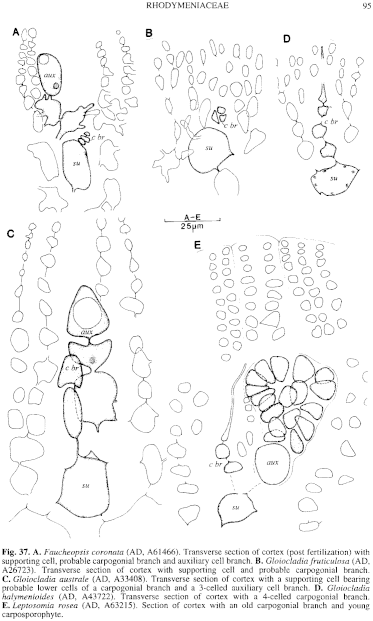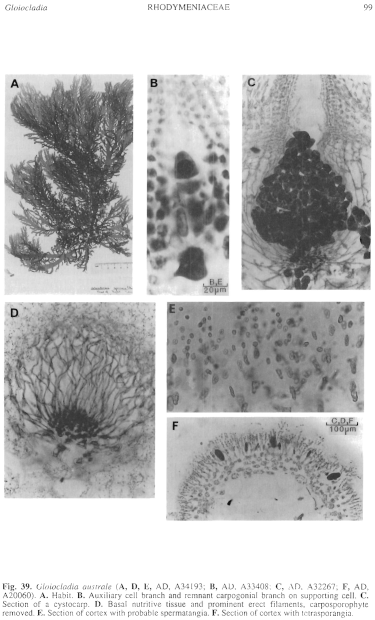|
|
|
|
|
|||||||||||
|
Electronic Flora of South Australia Species Fact Sheet
Phylum Rhodophyta – Class Florideophyceae – Order Rhodymeniales – Family Rhodymeniaceae
Synonyms
Gloioderma australis J. Agardh 1851: 244. De Toni 1900b: 496. Harvey 1863, synop.: xliv. Kylin 1931: 7. Searles 1984: 220.
Horea speciosa Harvey 1859b: 328, pl. 194A; 1863, synop.: xlv. J. Agardh 1876: 292. Reinhold 1898: 46. Sonder 1881: 17. Tisdall 1898: 505. Wilson 1892: 180.
Gloioderma speciosa (Harvey) J. Agardh 1872: 18. Guiler 1952: 93. Kylin 1931: 7. Searles 1984: 220. Sparling 1957: 329. Womersley 1950: 174.
Callophyllis australis Sonder 1848: 175. De Toni 1897: 287. Kützing 1849: 746. Reinbold 1897: 45.
Haligone rosea Kützing 1866: 23, pl. 66a, b. J. Agardh 1876: 353.
Gloioderma tasmanicum Zanardini 1874: 503. De Toni 1900b: 497. Kylin 1931: 7. Lucas 1929b: 49. Lucas & Perrin 1947: 194, fig. 62.
Horea tasmanica (Zanardini) Sonder 1881: 17.
Bindera ramosa J. Agardh 1894: 129. De Toni 1900b: 549. Kylin 1931: 31, pl. 18 fig. 41.
Thallus (Fig. 39A) medium to dark red to red-brown, fading to grey-red, (10–) 20–40 cm high, soft and mucilaginous, complanately branched with flat, irregularly pinnate branches for 3–4 orders, main branches (3–) 6–10 mm broad, bearing marginal pinnate branches 3–10 cm long and also simple branchlets 3–10 mm long, with ultimate branchlets 1–2 mm broad; compact, rounded, potentially adhesive, discs 2–3 mm across, terminate few to numerous branchlets. Holdfast discoid, with adhesions also by the discs of dense, elongate cells; usually epiphytic on sea-grasses or larger algae, or epilithic (?). Structure multiaxial, developing a cortex 50–90 µm thick of slender branched filaments 5–8 cells long, with the lower 2–3 cells irregular, 5–10 µm broad, and the upper 3–5 cells ovoid, 2–3 µm in diameter, arising from the lax inner cortex (Fig. 39F) of ovoid cells 15–25 µm in diameter. Medulla 3–5 cells thick, cells large, ovoid, 60–200 (–250) µm in diameter, with frequent secondary pit-connections. Hairs on outer cortical cells common. Rhodoplasts discoid to elongate in cortical cells, ribbon like in medullary cells.
Reproduction: Gametangial thalli monoecious. Carpogonial branches 4(?)-celled, borne on a relatively large globular supporting cell (Fig. 37C) which also bears a 3-celled auxiliary cell branch, the upper auxiliary cell with a large spherical proteinaceous inclusion (Fig. 39B). Carposporophyte (Fig. 39C) ovoid, 250–500 µm across, with an erect fusion cell with erect branches bearing lobes of ovoid carposporangia 20–25 µm in diameter. Basal nutritive tissue of short cells, pit-connected to the supporting cell and auxiliary initial cell, with erect filaments (Fig. 39D) of prominent, persistent elongate cells around the carposporophyte and upper short-celled filaments around the ostiole. Cystocarps mostly marginal (also on the surface of broader branches), 0.7–1.5 mm across, with 2–4 horns, ostiolate. Spermatangia (Fig. 39E) cut off from outer cortical cells, ovoid, 1–2 µm in diameter.
Tetrasporangia (Fig. 39F) scattered, or in nemathecia with extended cortical filaments, pit-connected to mid cortical cells, elongate ovoid, 16–24 µm in diameter, decussately divided.
Type from "Occid. Nov. Ho11." (Mus. Paris); holotype in Herb. Agardh, LD, 25674.
Selected specimens: Point Peron, W. Aust., drift (Royce 482, 28.i.1951; AD, A15470). Head of Great Australian Bight, S. Aust., drift (Womersley, 4.ii.1954, AD, A19218 -"Marine Algae of southern Australia" No. 92) and (Gordon, 4.xi.1968; AD, A34193). Point Avoid, S. Aust., drift (Womersley, 2.xii.1975; AD, A46914). Tiparra Reef, S. Aust., 11–12 m deep (Shepherd, 24.ii.1971; AD, A38229). Cable Hut Bay, Yorke Pen., S. Aust., drift (Woelkerling, 17.i.1968; AD, A32267). Investigator Strait, S. Aust., 34 m deep (Watson, 20.i.1971; AD, A39220). Off Troubridge Light (Edithburg), S. Aust., 17 m deep (Shepherd, 4.ii.1969; AD, A33429). Marion Light, Gulf St Vincent, S. Aust., 15 m deep (Shepherd, 5.ii.1969; AD, A33408). Vivonne Bay, Kangaroo I., S. Aust., drift (Womersley, 30.i.1956; AD, A20174). Pennington Bay, Kangaroo I., S. Aust., drift (Womersley, 31.xii.1949; AD, Al2816). 1.3 km off Cape Northumberland, S. Aust., 15 m deep (Shepherd, 1.ii.1978; AD, A55045). Shoreham, Vic., drift (Lee, 5.iii.1961; AD, A24869). Walkerville, Vic., drift (Sinkora A2176, 9.iii.1975; AD, A48405). Low Head, Tas. (Perrin 764, 25.ii.1942; BM).
Distribution: Point Peron, W. Aust. to Walkerville, Vic., and the N coast of Tasmania.
Taxonomic notes: The holotype specimen of G. australis appears to be a small plant of the species more commonly known as G. speciosa, but it is unusual in having small surface proliferations. Only a few specimens with surface proliferations have been seen. The type is from Western Australia, where only two species of Gloiocladia are known - G. australe (G. speciosa) and G. halymenioides; of these two, it is certainly not the second.
G. australe differs from G. halymenioides in habit, having more irregularly pinnate branching, usually slightly broader main branches, and not tapering evenly to the apices as does the latter, and in possessing the rounded, discoid, ends to branchlets which can apparently adhere to the host as secondary holdfasts. It is usually a deep-water species and commonly (always?) epiphytic on sea-grasses whereas G. halymenioides is usually epilithic.
Horea speciosa Harvey, type from Georgetown, Tas., (lectotype in TCD - Alg. Aust. Exsicc. 439) is a well developed specimen of G. australe; G. speciosa has been the most frequently used name for this species.
Haligone rosea Kützing (1866, p. 23, pl. 66a, b), from Phillip I., Vic. (Mueller), type in L, 941, 61...67, is Gloiocladia australe, not Gloiocladia halymenioides as given by De Toni (1900b, p. 497).
Gloioderma tasmanicum Zanardini (1874, p. 503) from Georgetown, Tas., type in Museo Civico di Storia Naturale, Venice, is Gloiocladia australe.
Bindera ramosa J. Agardh (1894, p. 129) from Western Port, Vic. (Wilson, 6.iv.1893), lectotype in Herb. Agardh, LD, 25729, is also G. australe.
Callophyllis australis Sonder (1848, p. 175) from W. Aust. (Preiss), holotype (with Sonder's illustrations) in MEL, 1005769, appears to be a fragment of G. australe. Although this is the earliest specific epithet, its use is prevented by the use of G. australe, by Norris (1991).
References:
AGARDH, J.G. (1851). Species Genera et Ordines Algarum. Vol. 2, Part 1, I-XII, 1–336 + index. (Gleerup: Lund.)
AGARDH, J.G. (1872). Bidrag till Florideernes Systematik. Acta Univ. lund. 8, 1–60.
AGARDH, J.G. (1876). Species Genera et Ordines Algarum. Vol. 3, Part 1 — Epicrisis systematis Floridearum, pp. i-vii, 1–724. (Weigel: Leipzig.)
AGARDH, J.G. (1894). Analecta Algologica. Cont. I. Acta Univ. lund. 29, 1–144, Plates 1, 2.
DE TONI, G.B. (1900b). Sylloge Algarum omnium hucusque Cognitarum. Vol. 4. Florideae. Sect. 2, pp. 387–776. (Padua.)
GUILER, E.R. (1952). The marine algae of Tasmania. Check List with localities. Pap. Proc. R. Soc. Tasm. 86, 71–106.
HARVEY, W.H. (1859b). Algae. In Hooker, J.D., The Botany of the Antarctic Voyage. HI Flora Tasmaniae. Vol. II, pp. 282–320. (Reeve: London.)
HARVEY, W.H. (1863). Phycologia Australica. Vol. 5, Plates 241–300, synop., pp. i-lxxiii. (Reeve: London.)
KÜTZING, F.T. (1849). Species Algarum. (Leipzig.)
KÜTZING, F.T. (1866). Tabulae Phycologicae. Vol. 16. (Nordhausen.)
KYLIN, H. (1931). Die Florideenordnung Rhodyméniales. Lunds Univ. Årsskr. N.F. Avd. 2, 27 (11), 1–48, Plates 1–20.
LUCAS, A.H.S. & PERRIN, F. (1947). The Seaweeds of South Australia. Part 2. The Red Seaweeds. (Govt Printer: Adelaide.)
LUCAS, A.H.S. (1929b). A census of the marine algae of South Australia. Trans. R. Soc. S. Aust. 53, 45–53.
NORRIS, R.E. (1991). Some unusual marine red algae (Rhodophyta) from South Africa. Phycologia 30, 582–596.
REINBOLD, T. (1897). Die Algen der Lacepede und Guichen Bay und deren näherer Umgebung (Süd Australien), gesammelt von Dr. A. Engelhart-Kingston. Nuova Notarisia 8, 41–62.
SEARLES, R.B. (1984). North Carolina marine algae. XII. Gloioderma rubrisporum sp. nov. (Rhodophyta, Rhodyméniales). Bull. Torrey Bot. Club. 111, 217–221.
SONDER, O.W. (1848). Algae. In Lehmann, C., Plantae Preissianae. Vol. 2, pp. 161–195. (Hamburg.)
SONDER, O.W. (1881). In Mueller, F., Fragmenta Phytographiae Australiae. Supplementum ad volumen undecinum: Algae Australianae hactenus cognitae, pp. 1–42, 105–107. (Melbourne.)
SPARLING, S.R. (1957). The structure and reproduction of some members of the Rhodymeniaceae. Univ. Calif Pubis Bot. 29, 319–396.
TISDALL, H.T. (1898). The algae of Victoria. Rep. 7th Meet. Aust. Ass. Adv. Sci., Sydney, 1898, pp. 493–516.
WILSON, J.B. (1892). Catalogue of algae collected at or near Port Phillip Heads and Western Port. Proc. R. Soc. Vict. 4, 157–190.
WOMERSLEY, H.B.S. (1950). The marine algae of Kangaroo Island. III. List of Species 1. Trans. R. Soc. S. Aust. 73, 137–197.
ZANARDINI, J. (1874). Phyceae Australicae novae vel minus cognitae. Flora (Regensburg) 57, 486–490, 497–505.
The Marine Benthic Flora of Southern Australia Part IIIB complete list of references.
Publication:
Womersley, H.B.S. (28 June, 1996)
The Marine Benthic Flora of Southern Australia
Rhodophyta. Part IIIB. Gracilarialse, Rhodymeniales, Corallinales and Bonnemaisoniales
Reproduced with permission from The Marine Benthic Flora of Southern Australia Part IIIB 1996, by H.B.S. Womersley. Australian Biological Resources Study, Canberra. Copyright Commonwealth of Australia.
Illustrations in Womersley Part IIIA, 1996: FIGS 37C, 39.

Figure 37 enlarge
Fig. 37. A. Faucheopsis coronata (AD, A61466). Transverse section of cortex (post fertilization) with supporting cell, probable carpogonial branch and auxiliary cell branch. B. Gloiocladia fruticulosa (AD, A26723). Transverse section of cortex with supporting cell and probable carpogonial branch. C. Gloiocladia australe (AD, A33408). Transverse section of cortex with a supporting cell bearing probable lower cells of a carpogonial branch and a 3-celled auxiliary cell branch. D. Gloiocladia halymenioides (AD, A43722). Transverse section of cortex with a 4-celled carpogonial branch. E. Leptosomia rosea (AD, A63215). Section of cortex with an old carpogonial branch and young carposporophyte.

Figure 39 enlarge
Fig. 39. Gloiocladia australe (A, D, E, AD, A34193; B, AD, A33408; C, AD, A32267; F, AD, A20060). A. Habit. B. Auxiliary cell branch and remnant carpogonial branch on supporting cell. C. Section of a cystocarp. D. Basal nutritive tissue and prominent erect filaments, carposporophyte removed. E. Section of cortex with probable spermatangia. F. Section of cortex with tetrasporangia.

|
Email Contact: State Herbarium of South Australia |

|